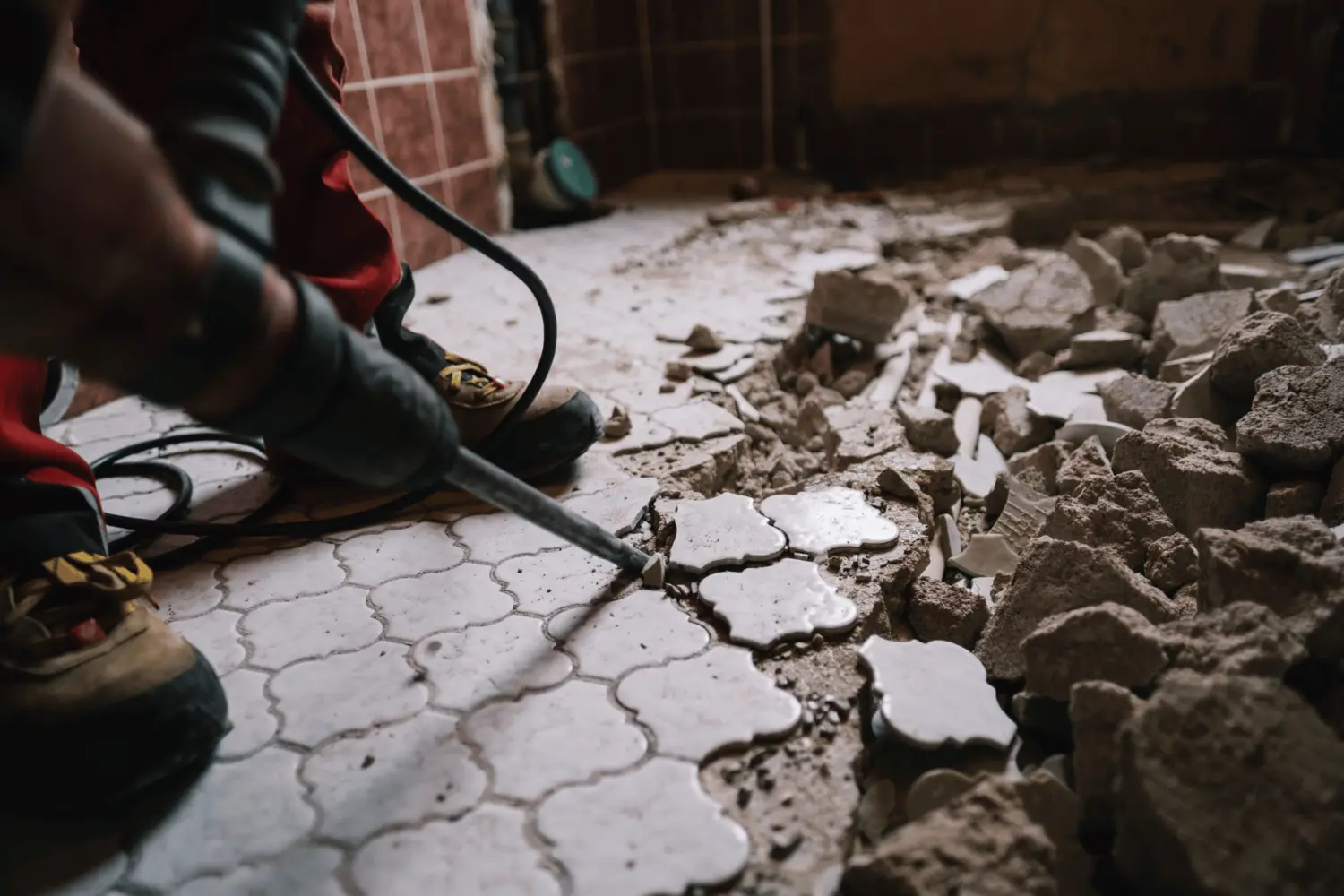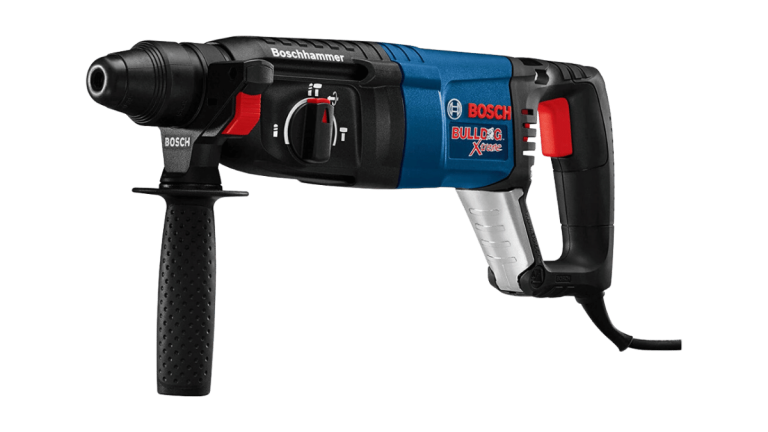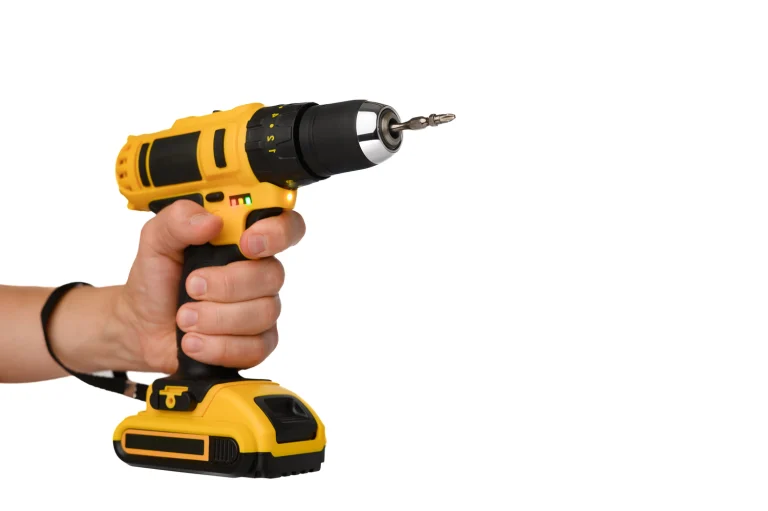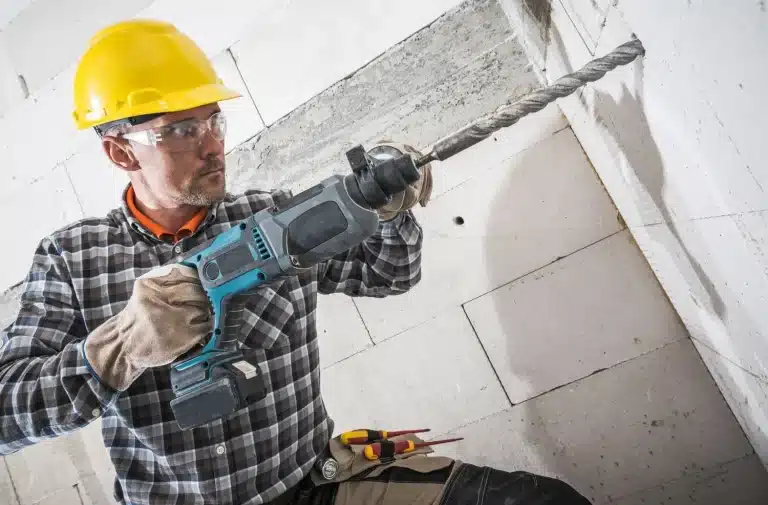Best Hammer Drill for Tile Removal – Conquer Demo Day
Finally ready to start knocking out that old ugly tile in your bathroom or kitchen? Did you get on your knees with a hammer and chisel and think, “there’s got to be a better way”?
You’re right – there is. Choose one of these bad boys and get the job done quicker and easier than you ever thought possible.
Are you remodeling a small 25 sq. ft. powder room or a huge 1,000 sq. ft. dance hall in your mansion? Either way, the best hammer drill for your tile removal project is here.
The best part of any DIY project is buying a new tool, right? Stop putting it off, order one of these, and bask in the glory of a demo day well done.
Features to Look For When Choosing Hammer Drills for Removing Tile
I know you want to get right to the fun part. There’s more to choosing a hammer drill for tile removals than you think. Before you get too far and end up ordering something you aren’t happy with, consider these factors.
- Corded vs Cordless: For me, cordless is the way to go when you’re removing tiles, especially ceramic floor tile. Constantly trying to avoid a cord is a quick route to frustration. There are exceptions to every rule though – if you have a big space, you might want to go corded for uninterrupted demolition. Or invest in a few extra batteries.
- Ergonomics: You’re going to have to get down on the floor to remove tile, but the right orientation can help save your back. A traditional drill shape, while lighter, is also a lot smaller. It will force you to bend further than a D-handle setup that lengthens the tool. Your face would also be a lot closer to the dust and debris. Go D-handle here. You can thank me later.
- Vibration: These are essentially a handheld jackhammer that you can use in your home. Unless you want to feel tingly for the next week, look for some kind of vibration control.
- Multi-mode: You’re going to need something with a hammer function in addition to a drill mode. The spinning part isn’t needed for this task. But always nice to have some versatility for future plans.
- Bit Security: The last thing you want is your chisel bit flying on you. Pick one with an SDS chuck. Fun fact: “SDS” originally came from German – “Steck-Dreh-Sitz” meaning Insert-Twist-Stay. (Pull that one out at your next barbeque. You’re welcome). Now it’s commonly referred to as Slotted Drive System. Along with making it super easy to change the bits, it’ll prevent an embarrassing ER trip.
Speaking of the ER: don’t start chipping without safety gear. You’ll need glasses, a dust mask, gloves, and work boots at least.
With that out of the way, time to get down to the business of the best hammer drills.
Winner Winner Chicken Dinner: Best Cordless Demolition Hammer
DEWALT 20V MAX* XR Rotary Hammer Drill Kit (DCH133M2)
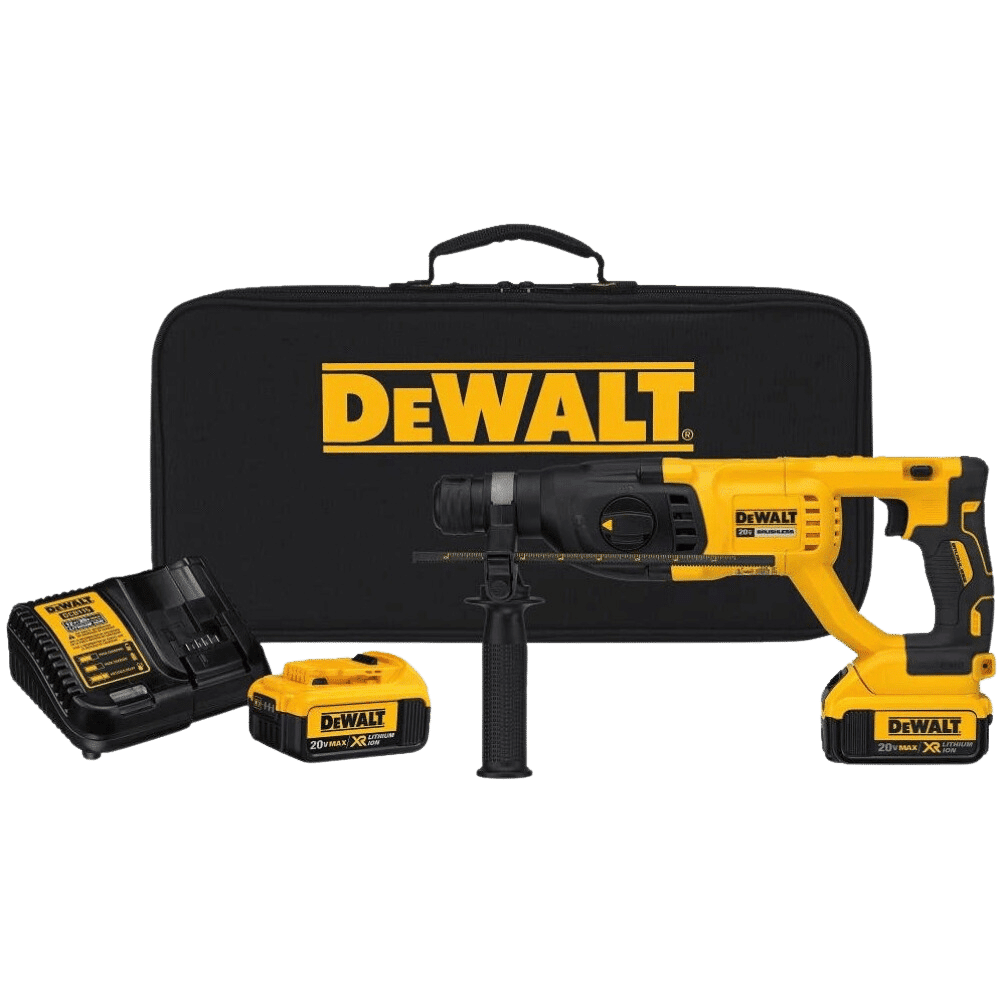
When you’re elbow-deep in a DIY project, particularly one as challenging as tile and grout removal, you need a tool that won’t let you down. That’s where the DeWalt 20V MAX* XR Rotary Hammer Drill comes into play. I’ve seen my fair share of tools, but this one? It’s a game-changer.
Power and Performance
First impressions – this one has the power. The XR brushless motor is not just for durability; it’s a high performer. When I first pulled the trigger on this demolition hammer, the chisel tip cut through the grout like it was just a pile of dust. And the battery life is great. It’ll definitely get you through a mid-sized room on a single charge.
Ergonomics and Comfort
Handling this drill is a breeze. It has my preferred D-handle design that keeps you more upright and out of the way of flying tile chips. It’s still small enough to get into tight areas, which, let’s face it, we always seem to find.
Precision and Control
The variable speed trigger is one of my favorite features. Squeeze gently when you first start to break through the grout, then crush it when you’re all lined up. DeWalt’s vibration control technology is also outstanding. No tingly hands even after buzzing away for a few hours.
Pros and Cons
As much as I’m a fan, no tool is without its flaws. Let’s break it down:
Pros:
- Powerful Brushless Motor: It doesn’t just talk the talk; it walks the walk.
- Extended Battery Life: Keep going without the constant pit stops for recharging.
- Ergonomic Design: Say goodbye to post-demo aches and pains.
- Variable Speed Control: Precision at your fingertips.
Cons:
- Price Tag: It’s an investment. But remember, you get what you pay for.
- Weight: While it’s not the heaviest, some might find it a bit more to handle than lighter models.
Top Corded Hammer Drill for Continuous Power in Large Spaces
BOSCH Bulldog Xtreme SDS-Plus Rotary Hammer (11255VSR)

When it comes to tackling large spaces, a cord can be as much of a blessing as a nuisance. The time saved waiting for batteries to charge will more than offset the avoid the cord dance.
Unmatched Strength and Efficiency
What sets this BOSCH model apart is its robust motor. When I put it to the test, the raw power brought a grin to my face. It chews through grout and tile with such ease that you’ll wonder if it’s actually enjoying the job. And since you have the cord, only a tripped breaker or blown fuse will stop you. I didn’t have any trouble here, but as with any power tool, try to limit other devices on the circuit you’re using for best results.
Comfort and Precision
Even with its powerful performance, it’s surprisingly manageable. The vibration control and variable speed trigger rival those of the DeWalt. Whether it’s delicate tile edges or full-on demolition, this drill adapts to your touch.
Pros and Cons
Every tool has its highlights and downfalls, and this BOSCH Bulldog is no exception.
Pros:
- Powerful Performance: It’s like the Hulk of hammer drills.
- Non-stop Power Supply: Thanks to the cord, the power is always on.
- Ergonomic Design: Your arms will thank you.
- Versatile Speed Control: It’s not just powerful, it’s precise.
Cons:
- Cord Restriction: You’ll be dodging the cord here and there. Without a good extension, you may have to change outlets periodically.
- Weight: It’s on the heavier side, which might be a downside for some.
The Value Pick – Break Tiles, not your Wallet
Berserker SDS-Plus Rotary Hammer Drill with Vibration Control
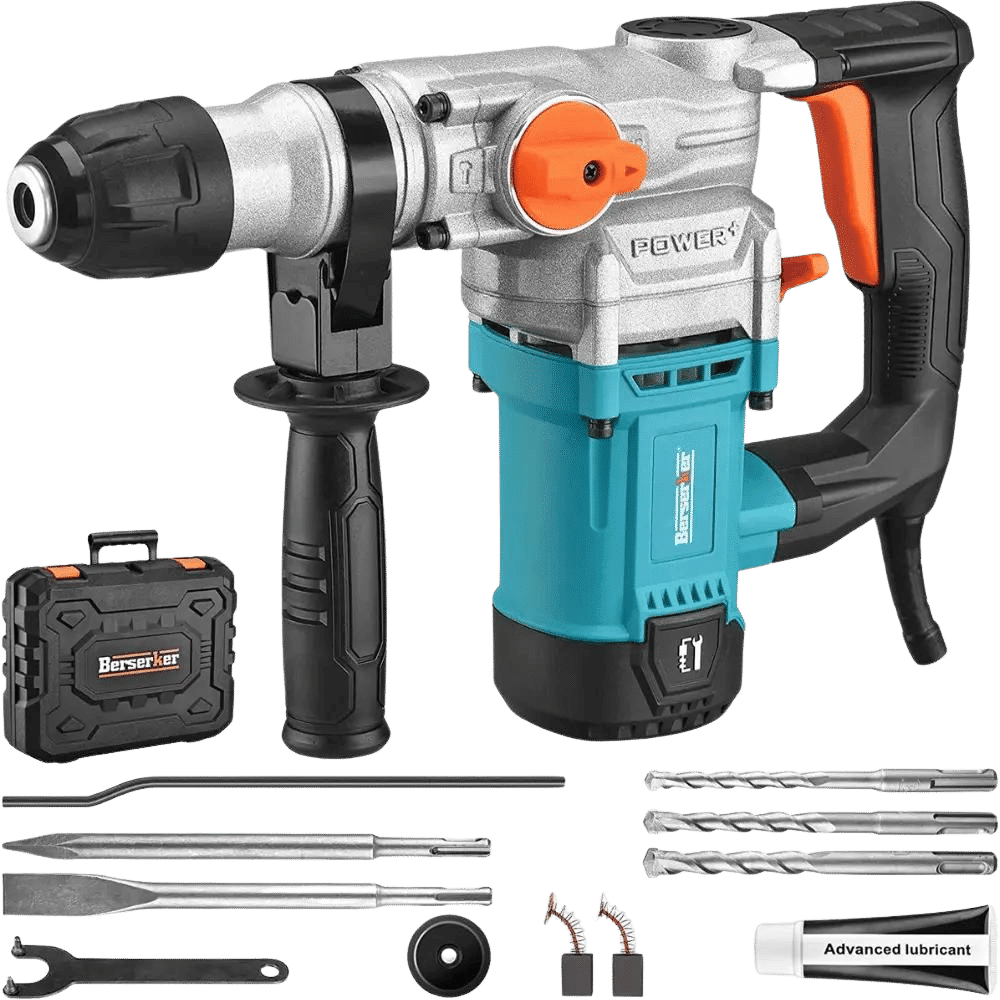
For those of us who love staying on budget, the Berserker SDS-Plus Rotary Hammer Drill offers a fantastic balance of quality and affordability. It’s a rare find – a tool that doesn’t break the bank but also doesn’t skimp on performance.
Performance and Features that Punch Above their Weight
What struck me first about this drill is how it manages to offer substantial power without the hefty price tag. It’s tile removing capabilities surprised me at less than half the cost of the others on this list. It’s also amazing that this thing has vibration control. Usually, at lower price points, comfort can be compromised, but not with this one. It’s surprisingly easy on the hands and arms, even during extended use.
Practical Design for Everyday Use
The drill feels balanced and manageable, which is a big plus for those not used to handling heavier-duty tools. It’s not just for tile removal. This drill can take on a variety of materials, making it a versatile addition to any DIY toolkit.
Pros and Cons: A Fair Perspective
Every tool has its highs and lows, and it’s no different with the Berserker SDS-Plus.
Pros:
- Affordability: It’s hard to beat the price for the quality you get.
- Comfortable to Use: The vibration control really makes a difference.
- Solid Performance: It delivers more than what you’d expect.
- Versatile for Various Projects: More than just a one-trick pony.
Cons:
- Build Quality: While decent, it might not endure as long as higher-priced models.
- Power Limitations: For extremely tough materials, it may struggle a bit.
Smart Tech to Prevent a Breakdown
Milwaukee M18 Fuel 18V Lithium-Ion Brushless Cordless SDS Plus D-Handle Rotary Hammer (2713-20)
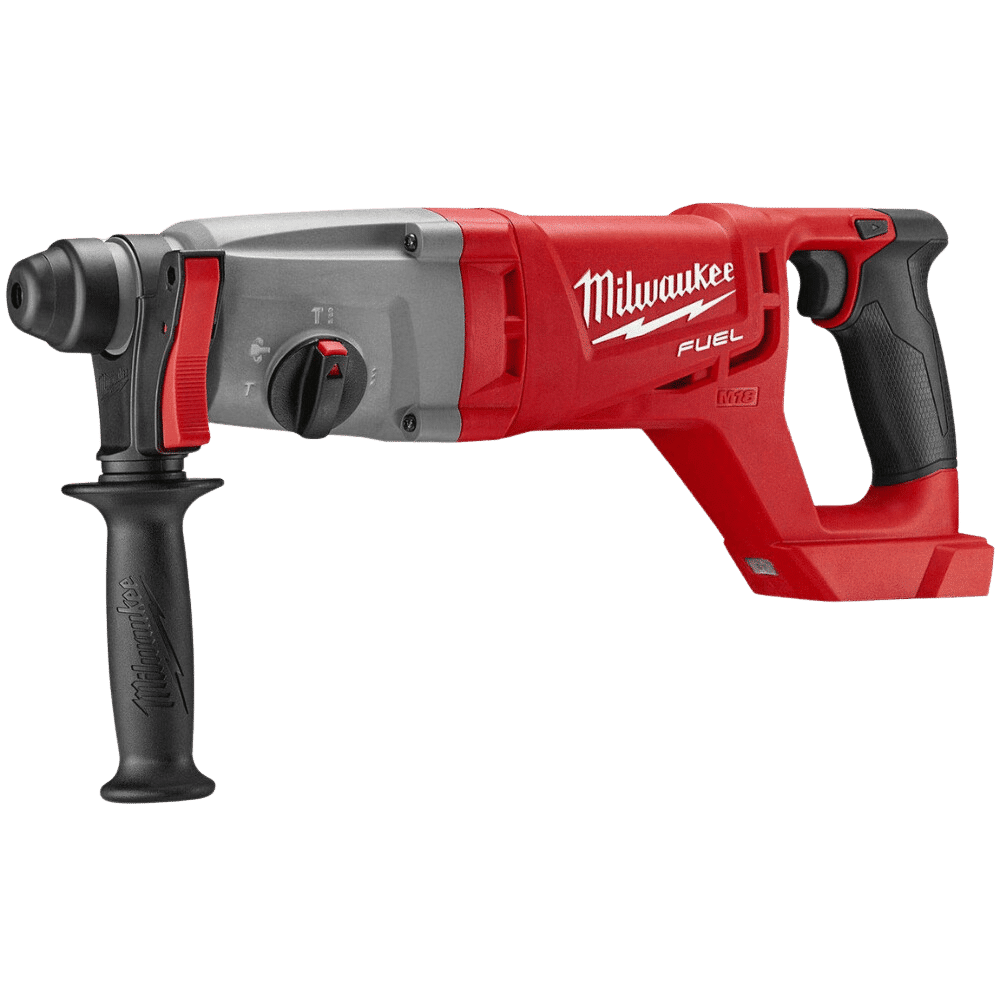
In the world of hammer drills, the Milwaukee 2713 stands out, especially for its advanced technology that prevents breakdowns. A tool’s durability is just as important as its power. And this Milwaukee model? It won’t let you down.
Cutting-Edge Technology for Unmatched Durability
The REDLINK PLUS™ Intelligence is where the magic happens. The drill is equipped with this exclusive technology, which is essentially a guardian angel for your tool. It protects against overloading, overheating, and over-discharging. I’ve pushed this drill hard, and not once did it falter or show signs of strain. Whether you’re dealing with tile, concrete, or masonry, this drill keeps its cool. The peace of mind knowing that your tool won’t overheat mid-project is priceless.
Performance and User-Friendly Features
The balance between power and control is spot on. It delivers a punch but doesn’t run away from you. This means cleaner, more precise work. It’s also evident that thought has gone into its design. The comfortable grip and balance reduce fatigue, making longer projects more manageable.
Pros and Cons
As with the rest, there are highs and lows. Here’s my take:
Pros:
- Advanced Protection Technology: The REDLINK PLUS™ is a game-changer for tool longevity.
- Consistent Performance: It doesn’t lose steam, even under strenuous use.
- User Comfort: Designed to be used for extended periods without discomfort.
- Versatile Applications: Not just for tiles, it’s a multi-surface pro.
Cons:
- Price Point: It’s an investment, but for good reason.
- Battery Dependency: Being cordless means keeping an eye on battery life, especially during longer tasks.
Great Choice for More than Just Tile Removal
Makita 18V LXT® Lithium-Ion Cordless 7/8″ SDS-Plus Rotary Hammer (XRH04Z)

If you already have a list of tasks for your hammer drill after removing the tile, the Makita XRH04Z is a good choice. I’ve seen tools that are great for one job but fall short in others. Not this Makita. It’s like the Swiss Army knife of hammer drills.
Versatility and Power in One Package
Beyond tile removal, this drill shines in a variety of tasks. Whether it’s drilling into concrete or chiseling through brick, its performance remains top-notch. I’ve personally used it on multiple materials, and it hasn’t missed a beat. The 18V LXT® battery provides a surprising amount of power for a cordless tool. It’s more than enough to take care of any project on your list.
User-Friendly Features
One of the first things I noticed was its weight – or lack thereof. It’s light enough to maneuver easily, yet sturdy enough to feel reliable in your hands. The built-in LED light is a simple but game-changing feature. It’s a lifesaver when working in dimly lit areas, or when your head is casting a shadow.
Pros and Cons
Even with its impressive capabilities, it’s important to weigh both sides.
Pros:
- Versatile Use: It’s not just for tiles; it’s a multi-surface champion.
- Cordless Convenience: Freedom from cords means freedom to move.
- Lightweight Design: Easy on the arms, tough on materials.
- Built-In LED Light: A small feature with a big impact on precision.
Cons:
- Battery Life: While decent, heavy-duty tasks might require spare batteries.
- Power Limitations: For extremely heavy-duty jobs, it might fall short compared to corded giants.
Frequently Asked Questions
Are rotary hammers and hammer drills the same?
No, rotary hammers and hammer drills are not the same. While both tools can drill into hard materials, they differ in mechanism and strength. Hammer drills use a rapid hammering action to chip away material as the drill bit rotates, suitable for light masonry work like drilling into bricks or concrete blocks. Rotary hammers, on the other hand, use a piston mechanism to deliver a more powerful hammer blow, making them ideal for heavy-duty tasks such as drilling into concrete or tile removal. Rotary hammers are generally more powerful and efficient for demanding masonry work compared to hammer drills.
What are some tips and tricks to efficiently remove tile with a hammer drill?
Tile removal is a process, you don’t just line up and go maximum speed through the grout and mortar. Here are some easy tips for removing tile with a hammer drill:
- Safety First: Always wear safety goggles and gloves to protect your eyes and hands.
- Choose the Right Bit: Use chisel bits in your hammer drill. It’s like a flat blade that helps lift the tiles.
- Start on a Broken Tile: If there’s already a cracked tile, start there. It’s easier to get the chisel bit under it.
- Angle the Drill: Hold the drill at a slight angle, not straight down. It helps to slide the bit under the tiles.
- Gentle Tapping: Use the drill to gently tap and lift the tiles. Think of it like lightly tapping the edge of a cookie to break it.
- Move in Sections: Work on small areas at a time. Don’t try to remove a large area all at once.
- Patience is Key: Take your time. Rushing might break the tiles into smaller pieces, making it harder to clean up.
- Clean as You Go: As tile is removed, clear the broken tile pieces to keep your work area safe.
Can a hammer drill be used for other DIY projects besides tile removal?
Absolutely! A hammer drill can be used for many different DIY projects, not just for removing tiles. Here are a few things you can do with it:
- Drilling into Concrete: If you need to hang something on a concrete wall, a hammer drill is perfect for making holes in it.
- Working with Bricks: Need to put up something on a brick wall? A hammer drill can drill holes in bricks too.
- Putting Together Furniture: Sometimes, when building furniture, you need to drill holes. A hammer drill can do this easily.
- Making Holes in Metal or Wood: If you’re working on a project that needs holes in metal or wood, a hammer drill can help with that.
- Installing Lights or Fixtures: For putting up lights or other fixtures on hard surfaces, a hammer drill can make the right-sized holes.
How do corded and cordless hammer drills compare for tile removal tasks?
When you’re looking at corded and cordless hammer drills for removing tiles, they have some key differences. A corded hammer drill needs to be plugged into an outlet, and it’s usually more powerful, which is great for tough tile removal jobs. The best thing about corded drills is that you can use them as long as they’re plugged in, but they are generally heavier and the cord can limit how far you can move around.
On the other hand, a cordless hammer drill runs on batteries, making it more portable and easier to carry around. You don’t need an outlet to use it, which is handy. However, they might be a bit less powerful compared to corded ones and their battery can run out, so you might need to take breaks to recharge. They are often lighter, which makes them easier to handle.
So, while corded drills offer more power and continuous use, cordless drills provide more freedom of movement and ease of handling. The best choice depends on what’s more important for your specific tile removal project.
Final Thoughts
Grabbing one of these can significantly ease the challenge of your tile project.
We’ve explored a range of options, from the robust power of corded models to the convenient portability of cordless ones.
Each drill has its unique strengths, whether it’s advanced technology, versatility, or value for money.
Remember, the right tool not only makes the job easier but also ensures a clean slate for the new tile installation to start.
Click on the links provided to explore these options further and find the hammer drill that’s right for you.
Order yours today and take the first step towards easier, more efficient tile removal.

